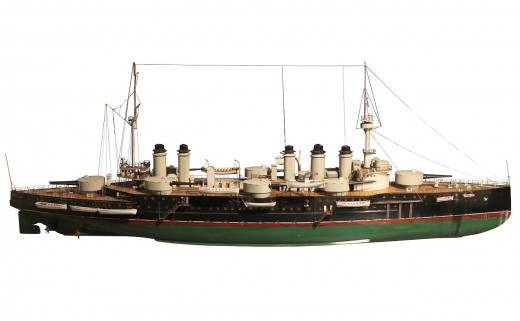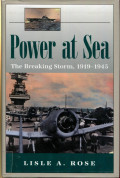French Battleships 1914-1945 Review

Ryan K. Noppen's book French Battleships 1914-1945 is an extremely slender volume. At barely 45 pages long, even a relatively specialized subject like French battleships in the beginning of the 20th century is something which one would be hard pressed to cover in any degree of convincing detail. Although certainly lacking in details that larger books have, Noppen does manage to write a work which is easily read and gives a good introductory summary into French battleship designs and their service, a good book for people getting into the subject. More advanced books however, are recommended for those already acquainted with it.
The introduction to the book covers the doctrinal thought behind late 19th century French naval strategy as well as the navy's evolution under rival factions and the influence of the Jeune Ecole naval school, and the French naval construction plans into which French semi-dreadnoughts and dreadnoughts would fit.
To begin in earnest, "Semi-Dreadnoughts and Dreadnoughts of the Marine Nationale" is devoted to covering the construction of the Danton class pre-dreadnoughts and why the French designed them as they did, and why they continued their construction, followed by the Courbet and Bretagne dreadnoughts. Each of these includes a table of their statistical information and a paragraph providing descriptive detail, as well as large drawings of them and various photographs.

"French Battleship Operations 1914-1919" looks at the rather disappointing nature of the struggle for the French, who had to contend with the passive fleet-in-being strategy of the Austrian navy, which the French were unable to take the offensive against. After the brief pursuit of the Goeben and Breslau, the French battleships largely played no role against enemy surface warships, other than a few brushes with the Austro-Hungarians, and only really saw use in providing gunnery support to forces landing in Greece. French battleships would only finally return to France however, in 1919, after being used to support the White Russians in the Russian Civil War until their crews mutinied and forced their return.
"Fast Battleships of the Marine Nationale" continues on with the post-WW1 era and the construction of the French Dunkerque-class battlecruisers, highly innovative and radical designs to counter German pocket battleships, and the Richelieus, essentially scaled-up Dunkerques.
"French Battleship Operations 1939-1945" looks at how French battleships served in WW2, devoting substantial attention to the Attack on Mers-el-Kebir and subsequent British attempts to destroy the French fleet in Dakar, Mers-el-Kebir, Egypt, and Britain. Jean Bart's battle at Casablanca against American forces during Operation Torch and the scuttling of the French fleet at Toulon as well as Richelieu's service in the Allied navies after refit end the chapter.
The conclusion summarizes the fate of the rest of the French battleships, destroyed by bombing, uses as training and depot ships, or scuttled as breakwaters, and the post-war decommissioning of French battleships.

The shortness of French Battleships 1914-1945 is both its strength and its weakness. It has a huge number of shortcomings and omissions, but most of what it treats with directly is reasonably well done. Some of what it writes could be easily found on wikipedia, but it manages to integrate together its subject into a cohesive story and one which could not be easily replaced by simply using online sources since none provide its cohesive look at the French battlefleet as a whole. The combination of dealing with both the reasons behind the ships and the French build policy, as well as their actual actions, is an effective one, which enables the book to treat rapidly and easily with its subject.
There are an impressive number of photographs, drawings, and designs of French battleships of the era, which are mostly well done, although there is an unfortunate lack of technical designs of French ships - illustrations and designs are intended for visual consumption rather than showing the interior of the ship, with only Richelieu's aviation facilities having blueprint schematics. Some of the drawings which do show the interior of the ship are unfortunately small in their details on critical parts of the ship, such as for Richelieu which has a cut away of the forward turret, but which due to showing the entire ship is so small as to render it difficult to see. But while the drawings might lack for detailed schematics, they are still quite well drawn and an impressive number are fit into a relatively small book.
Of course, there are inevitably large subjects which are left out. Particularly, there is little about what the French actually intended to do with their battleships, their doctrine and strategy. The book is content to recite the reasons behind French battleship construction in competition with other nations and their operations, but not the intended context in which French battleships were to operate - were they supposed to function in line-of-battle arrangements consistently throughout the era, heads of task forces, the fast battleships as hunter-killer ships, etc.? These key elements of doctrine and how the French were to use their ships are never discussed.
Furthermore, the book is focused only upon those battleships which were actually completed or variants of completed classes - there is nothing about the Lyon or Normandie class battleships, and nor about the various designs in the early 1920s or the Alsace class battleships. Although the book provides a decent overview of technical summaries for the battleships, it is merely surface deep, and there is little about more complicated technical aspects.
There are some battle scenarios or events which are left out, such as Jean Bart's escape from St. Nazaire, covered in sadly little detail. Although dreadnoughts were not used, the lack of any mention of the extensive service of French pre-dreadnoughts at Gallipoli is a sad omission. The book could have been comfortably extended until 1956, the last usage of French battleships in anger with Jean Bart's bombardment at Suez, without any real excess length. But overall the battles are covered well and serve as a useful centerpiece and center for the work.
While more lengthy volumes are needed to get an in-depth understanding of the French navy's battlefleet, regarding its design, doctrine, proposed projects, training, certain technical parameters of the ships, and other aspects of the more fine details, French Battleships 1914-1945 provides a reasonable and cohesive introduction into the subject. It is quickly read and understandable and hits on the important points of the French navy's battleship fleet. Osprey books attempt to do this - to provide an organized look into a subject for a beginner or a wide number of photographs for modelers and experts, and in this case it well matches the objective. For the short length of the book, it nevertheless is a welcome look into the French navy in the World Wars and Interwar.
© 2020 Ryan C Thomas









